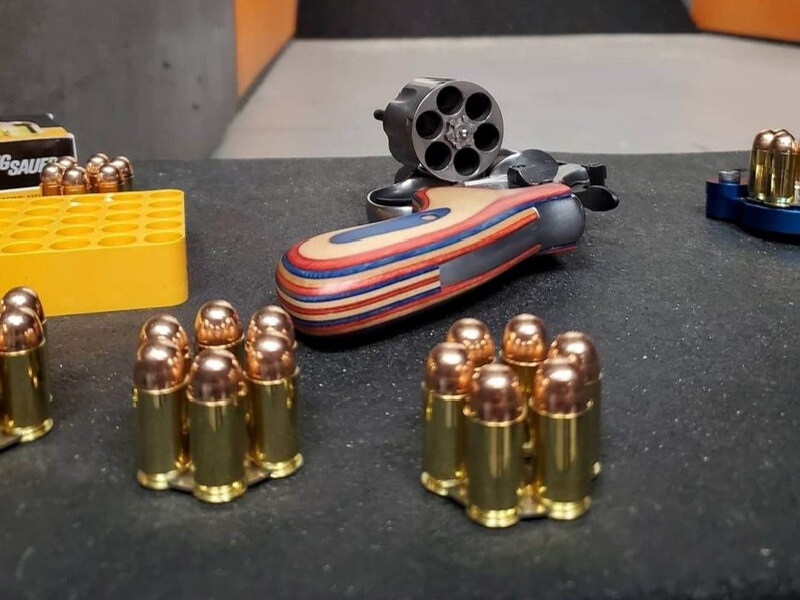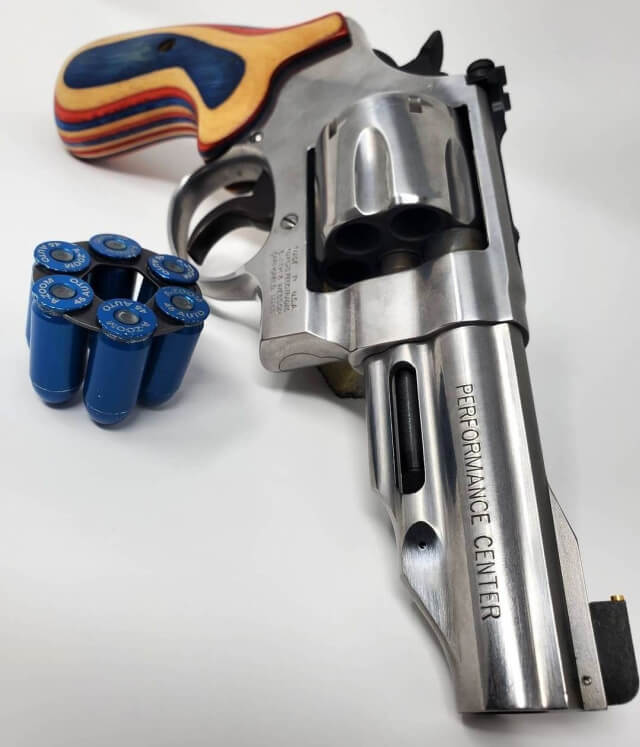I like guns whether they are semi-automatic handguns, revolvers, modern rifles, lever actions, or shotguns. However, I almost exclusively compete, train, and carry semi-automatic handguns. I have carried revolvers in the past, and still enjoy buying and shooting new ones.
Both semi-automatics and revolvers have advantages and disadvantages, especially for everyday carry. Though I have chosen semi-automatics for my carry needs, I don’t think I have a lot of bias when considering the advantages and disadvantages of semi-automatic versus revolver handguns. I have been considering going with the KS6 from Kimber as my backup gun.
There have been semi-autos chambered in revolver rounds (.357 and .44 Magnum most commonly) and revolvers in semi-auto rounds (9mm, .45ACP, and more recently 10mm). Recently, there has been a noticeable increase in companies offering revolvers chambered in semi-auto rounds. With this increase in options, I will admit my love of the 10mm round has tempted me to pick up a revolver designed specifically for semi-automatic ammunition.

But I have resisted these revolvers for the same reason my Desert Eagles (DE) are chambered in .50AE, not .44 Magnum. Additionally, I have lusted after but never bought a Coonan 1911 in .357. My reason for keeping semi-automatic ammo with the semi-automatics and revolver ammunition with revolvers is my love for both platforms is somewhat biased. I don’t think they should cross over to each other. Although you can make revolver ammo function in a semi-auto, my personal experience is that it is an engineering challenge and even meeting that challenge comes with some issues including a reduction of reliability, however slight. My DE in .50 AE, properly maintained and operated, is very reliable. My friend’s DE chambered in .44, not so much. Thus, my interest in semi-automatic handguns chambered in revolver rounds is low, especially when I can shoot those rounds in the guns they were intended for.
Comparisons
Revolvers have a simpler engineering fix to running semi-automatic ammunition: the moon clip. For those that only shoot revolvers, I can see some arguments for going to a semi-automatic round, as using moon clips can speed up reloads. Additionally, some semi-automatic rounds
(especially 9mm) are cheaper for practice. But if you shoot both, I don’t see a reason to get a revolver chambered in semi-auto as the disadvantages of revolvers are still present: capacity (both in the gun and reloads), concealability (both the gun and the reloads), reload times
(without substantially more practice), and adding a needed extra device to the process (moon-clips) outweigh the advantages of being less likely to malfunction and simplicity of initial operation.
A friend of mine suggested another advantage of revolvers chambered in semi-automatic ammunition: more stopping power from the same round due to velocity. His argument: as some of the energy of the semi-automatic goes to unlocking the barrel, driving the slide back, and ejecting the casing, that energy is not being used to drive the round down range. Thus, the same round from a revolver (no lost energy) with the same length barrel should leave the gun at a higher velocity and thus have more energy “stopping power.” I countered with other issues including the advantage of additional ‘muzzle’ length in the chamber, but the potential disadvantage of lost energy at the gap between cylinder and barrel.

The Test
As you may guess, I am not someone to let an argument stay theoretical. I decided to put this argument to the test. I first looked online for comparative tests and did not find much. As I thought about doing our own comparisons (any chance to run some velocity tests) I
realized one of the possible reasons why I didn’t find much previously published.
The two platforms are hard to compare. A 4” barrel in a revolver is just that, the barrel not counting the chamber (nor power loss between the chamber and barrel). A 4” barrel in a semi-automatic includes the chamber while a 4” barrel in a revolver does not, and may include a small distance within the chambers in the cylinder. Measuring from breech face to end of barrel I did not find an exact match between his semi-automatic firing revolvers and any of my semi-automatics.
Again, I did some online searching and brainstorming and used the breech face-to-muzzle end measurement to get closer but still did not find an exact match. I briefly considered custom cutting one of my semi-automatic barrels for an exact fit but decided on a simpler metric. Instead of matching exact barrel lengths, I matched the overall dimension on length for the test (the carried ‘print’ of the guns) and matched the barrels as closely as possible after the overall length measurement.
I ended up comparing various .45 ACPs semi-automatics and chose one that came closest in overall frame size and barrel length to the Smith & Wesson Performance Center Model 625 in .45 ACP. That gun was my Les Baer 1911 also in .45 ACP. The two guns were within a quarter inch in height, width, depth, and barrel length, with the revolver being slightly larger in every measurement, most specifically a 5¼” distance from breech face to muzzle on the revolver compared to 5” on the 1911.

Do you get more power shooting .45 ACP from a revolver vs. a 1911?
I shot groups of six from the S&W revolver and 1911 in sequence measuring velocity with a LabRadar chronograph set for the grain size and velocity ranges expected (using 230 gr S&B FMJ for all tests). Looking at velocity data from previous tests adding ¾” to a 1911 barrel (4.45″ to 5.0”) results in a general increase in 46 feet per second (fps). As the revolver (ignoring energy loss from the gap between the cylinder and barrel) was 5.25” to the 1911’s 5.0” barrel we could extrapolate that the extra .25” barrel should account for approximately 15 fps.

Results
Smith &Wesson .45 ACP Revolver: Average of 24 rounds: 848.17 fps: Power Factor 195.0
Les Baer 1911 .45 ACP Semi-Auto: Average of 24 rounds: 825.84 fps: Power Factor 189.29
The results are somewhat inconclusive but interesting enough that I plan to do some more tests. If the power loss from the cylinder to barrel gap was equal to the power loss from cycling a semi-automatic, we would have expected to see around a 15 fps gain in the revolver due to a slightly longer barrel. What we found was somewhat more (22.33 fps).
Does this strongly support the idea a semi-automatic round fired from a revolver has significantly more power than the round fired from a similar semi-automatic? No. But it does suggest it is a possibility worth further testing. It would be interesting to also look at 9mm rounds in a similar test as well as comparing striker-fired .45 ACP handguns to the Smith & Wesson .45 ACP. Overall, though a small gain was found, it was very near the expected gain based on the length of the barrel and did not strongly support any significant differences. It would also be interesting to test +P and other defensive rounds to see if the differences increase, decrease, or disappear.

What are your thoughts on this muzzle-to-muzzle match-up? Any suggestions for my next round of tests?


